 Technology peripherals
Technology peripherals
 AI
AI
 Setting the best threshold for machine learning models: Is 0.5 the best threshold for binary classification?
Setting the best threshold for machine learning models: Is 0.5 the best threshold for binary classification?
Setting the best threshold for machine learning models: Is 0.5 the best threshold for binary classification?
For binary classification, the classifier outputs a real-valued score, and then generates a binary response by thresholding the value. For example, logistic regression outputs a probability (a value between 0.0 and 1.0); observations with scores equal to or above 0.5 produce a positive output (many other models use a 0.5 threshold by default).
But using the default 0.5 threshold is not ideal. In this article I will show how to choose the best threshold from a binary classifier. This article will use Plomber to execute our experiments in parallel and use sklearn-evaluation to generate graphs.
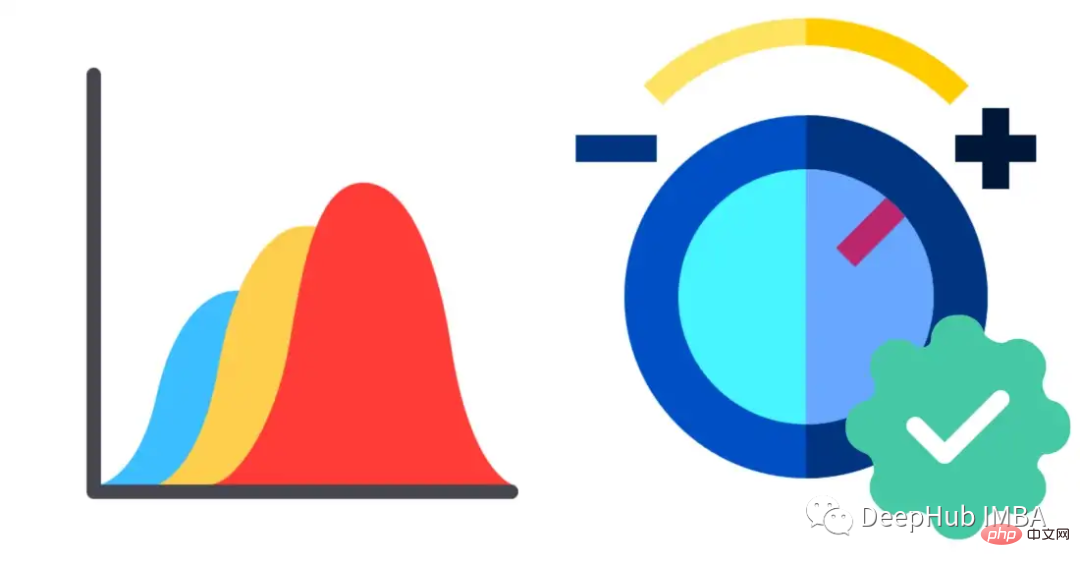
Here is an example of training logistic regression. Suppose we are developing a content moderation system, where the model flags posts containing harmful content (images, videos, etc.); a human then looks at it and decides whether the content should be removed.
Build a simple binary classifier
The following code snippet trains our classifier:
import matplotlib.pyplot as plt import matplotlib as mpl from sklearn import datasets from sklearn.linear_model import LogisticRegression from sklearn.model_selection import train_test_split from sklearn_evaluation.plot import ConfusionMatrix # matplotlib settings mpl.rcParams['figure.figsize'] = (4, 4) mpl.rcParams['figure.dpi'] = 150 # create sample dataset X, y = datasets.make_classification(1000, 10, n_informative=5, class_sep=0.4) X_train, X_test, y_train, y_test = train_test_split(X, y, test_size=0.3) # fit model clf = LogisticRegression() _ = clf.fit(X_train, y_train)
Now let us make predictions on the test set and evaluate it through the confusion matrix Performance:
# predict on the test set y_pred = clf.predict(X_test) # plot confusion matrix cm_dot_five = ConfusionMatrix(y_test, y_pred) cm_dot_five
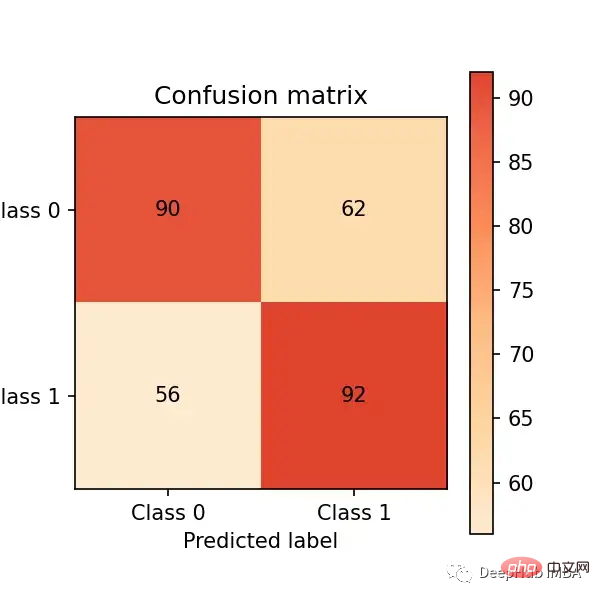
The confusion matrix summarizes the performance of the model in four regions:
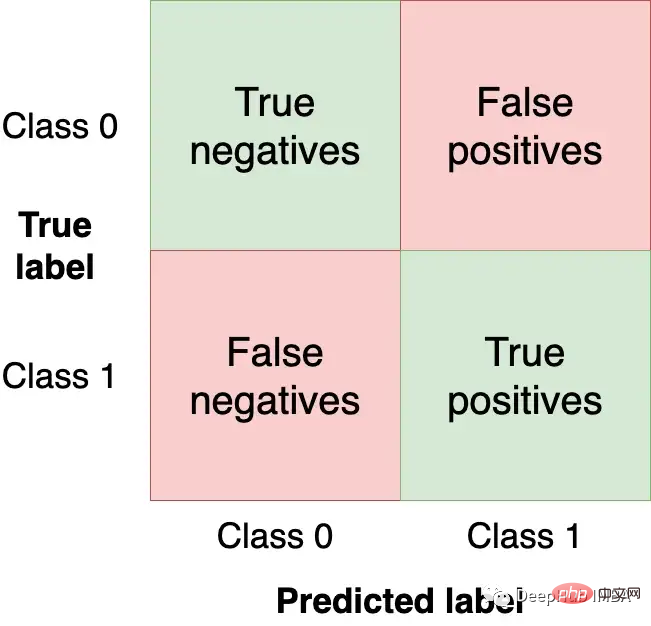
We want to have the top left and Get as many observations (from the test set) in the lower right quadrant as these are the correct observations for our model to get. The other quadrants are model errors.
Changing the model's threshold will change the values in the confusion matrix. In the previous example, using clf.predict, a binary response was returned (i.e. using 0.5 as the threshold); but we can use the clf.predict_proba function to get the raw probability and use a custom threshold:
y_score = clf.predict_proba(X_test)
We can Make our classifier more aggressive by setting a lower threshold (i.e. label more posts as harmful) and create a new confusion matrix:
cm_dot_four = ConfusionMatrix(y_score[:, 1] >= 0.4, y_pred)
The sklearn-evaluation library makes this easy Comparing the two matrices:
cm_dot_five + cm_dot_four
The upper part of the triangle comes from the threshold of 0.5, and the lower part comes from the threshold of 0.4:
- Both models predict 0 for the same number of observations (this is a coincidence). 0.5 threshold: (90 56 = 146). 0.4 threshold: (78 68 = 146)
- Lowering the threshold will result in more false negatives (from 56 cases to 68 cases)
- Lowering the threshold will greatly increase the number of true positives (from 92 cases) Added 154 cases)
Small threshold changes greatly affect the confusion matrix. We only analyzed two thresholds. Then if we can analyze the model performance across all values, we can better understand the threshold dynamics. But before that can happen, new metrics for model evaluation need to be defined.
So far, we have used absolute numbers to evaluate our models. To facilitate comparison and evaluation, we will now define two normalized metrics (their values are between 0.0 and 1.0).
Precision is the proportion of observed events that are labeled (for example, posts that our model considers harmful, they are harmful). Recall is the proportion of actual events retrieved by our model (i.e., out of all harmful posts, which proportion of them we were able to detect).
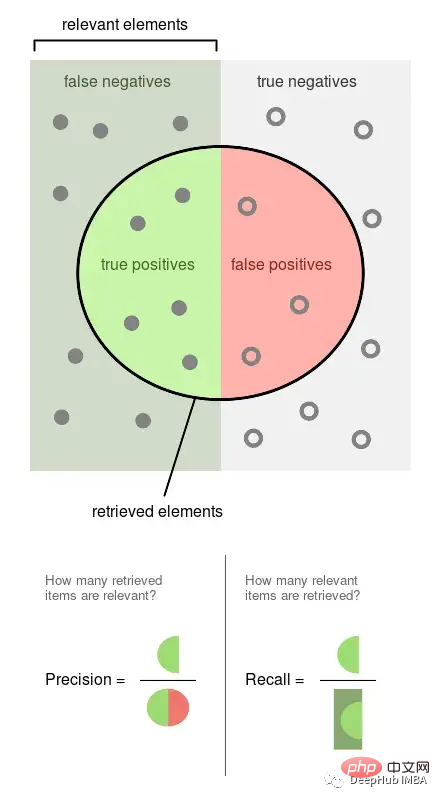
The above picture is from Wikipedia, which can well illustrate how these two indicators are calculated. Precision and recall are both proportional, so they are both 0 than 1 ratio.
Run the experiment
We will obtain precision, recall, and other statistics based on several thresholds to better understand how the thresholds affect them. We will also repeat this experiment multiple times to measure variability.
The commands in this section are all bash commands. They need to be executed in the terminal. If using Jupyter you can use the %%sh magic command.
Here we use Plomber Cloud to run our experiments. Because it allows us to run experiments in parallel and retrieve results quickly.
Created a Notebook that fit a model and calculated statistics for several thresholds, executing the same Notebook 20 times in parallel.
curl -O https://raw.githubusercontent.com/ploomber/posts/master/threshold/fit.ipynb?utm_source=medium&utm_medium=blog&utm_campaign=threshold
Let's execute this notebook (the configuration in the file will tell Plomber Cloud to run it 20 times in parallel):
ploomber cloud nb fit.ipynb
After a few minutes, we will see the 20 experiments complete:
ploomber cloud status @latest --summary status count -------- ------- finished 20 Pipeline finished. Check outputs: $ ploomber cloud products
Let’s download the experimental results stored in a .csv file:
ploomber cloud download 'threshold-selection/*.csv' --summary
Visualizing the experimental results
will load the results of all experiments and plot them in one go .
from glob import glob
import pandas as pd
import numpy as np
paths = glob('threshold-selection/**/*.csv')
metrics = [pd.read_csv(path) for path in paths]
for idx, df in enumerate(metrics):
plt.plot(df.threshold, df.precision, color='blue', alpha=0.2,
label='precision' if idx == 0 else None)
plt.plot(df.threshold, df.recall, color='green', alpha=0.2,
label='recall' if idx == 0 else None)
plt.plot(df.threshold, df.f1, color='orange', alpha=0.2,
label='f1' if idx == 0 else None)
plt.grid()
plt.legend()
plt.xlabel('Threshold')
plt.ylabel('Metric value')
for handle in plt.legend().legendHandles:
handle.set_alpha(1)
ax = plt.twinx()
for idx, df in enumerate(metrics):
ax.plot(df.threshold, df.n_flagged,
label='flagged' if idx == 0 else None,
color='red', alpha=0.2)
plt.ylabel('Flagged')
ax.legend(loc=0)
ax.legend().legendHandles[0].set_alpha(1)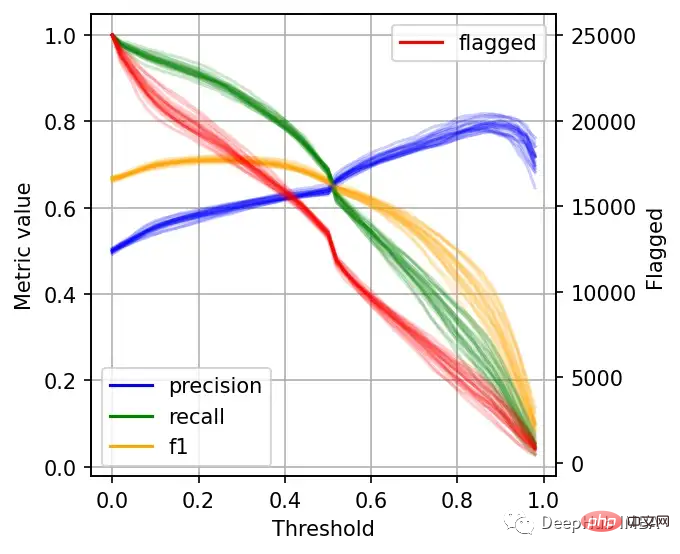
左边的刻度(从0到1)是我们的三个指标:精度、召回率和F1。F1分为精度与查全率的调和平均值,F1分的最佳值为1.0,最差值为0.0;F1对精度和召回率都是相同对待的,所以你可以看到它在两者之间保持平衡。如果你正在处理一个精确度和召回率都很重要的用例,那么最大化F1是一种可以帮助你优化分类器阈值的方法。
这里还包括一条红色曲线(右侧的比例),显示我们的模型标记为有害内容的案例数量。
在这个的内容审核示例中,可能有X个的工作人员来人工审核模型标记的有害帖子,但是他们人数是有限的,因此考虑标记帖子的总数可以帮助我们更好地选择阈值:例如每天只能检查5000个帖子,那么模型找到10,000帖并不会带来任何的提高。如果我人工每天可以处理10000贴,但是模型只标记了100贴,那么显然也是浪费的。
当设置较低的阈值时,有较高的召回率(我们检索了大部分实际上有害的帖子),但精度较低(包含了许多无害的帖子)。如果我们提高阈值,情况就会反转:召回率下降(错过了许多有害的帖子),但精确度很高(大多数标记的帖子都是有害的)。
所以在为我们的二元分类器选择阈值时,我们必须在精度或召回率上妥协,因为没有一个分类器是完美的。我们来讨论一下如何推理选择合适的阈值。
选择最佳阈值
右边的数据会产生噪声(较大的阈值)。需要稍微清理一下,我们将重新创建这个图,我们将绘制2.5%、50%和97.5%的百分位数,而不是绘制所有值。
shape = (df.shape[0], len(metrics))
precision = np.zeros(shape)
recall = np.zeros(shape)
f1 = np.zeros(shape)
n_flagged = np.zeros(shape)
for i, df in enumerate(metrics):
precision[:, i] = df.precision.values
recall[:, i] = df.recall.values
f1[:, i] = df.f1.values
n_flagged[:, i] = df.n_flagged.values
precision_ = np.quantile(precision, q=0.5, axis=1)
recall_ = np.quantile(recall, q=0.5, axis=1)
f1_ = np.quantile(f1, q=0.5, axis=1)
n_flagged_ = np.quantile(n_flagged, q=0.5, axis=1)
plt.plot(df.threshold, precision_, color='blue', label='precision')
plt.plot(df.threshold, recall_, color='green', label='recall')
plt.plot(df.threshold, f1_, color='orange', label='f1')
plt.fill_between(df.threshold, precision_interval[0],
precision_interval[1], color='blue',
alpha=0.2)
plt.fill_between(df.threshold, recall_interval[0],
recall_interval[1], color='green',
alpha=0.2)
plt.fill_between(df.threshold, f1_interval[0],
f1_interval[1], color='orange',
alpha=0.2)
plt.xlabel('Threshold')
plt.ylabel('Metric value')
plt.legend()
ax = plt.twinx()
ax.plot(df.threshold, n_flagged_, color='red', label='flagged')
ax.fill_between(df.threshold, n_flagged_interval[0],
n_flagged_interval[1], color='red',
alpha=0.2)
ax.legend(loc=3)
plt.ylabel('Flagged')
plt.grid()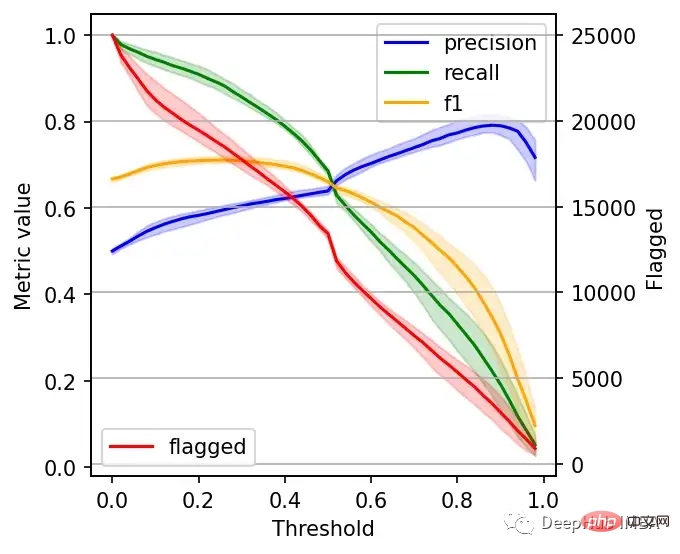
我们可以根据自己的需求选择阈值,例如检索尽可能多的有害帖子(高召回率)是否更重要?还是要有更高的确定性,我们标记的必须是有害的(高精度)?
如果两者都同等重要,那么在这些条件下优化的常用方法就是最大化F-1分数:
idx = np.argmax(f1_)
prec_lower, prec_upper = precision_interval[0][idx], precision_interval[1][idx]
rec_lower, rec_upper = recall_interval[0][idx], recall_interval[1][idx]
threshold = df.threshold[idx]
print(f'Max F1 score: {f1_[idx]:.2f}')
print('Metrics when maximizing F1 score:')
print(f' - Threshold: {threshold:.2f}')
print(f' - Precision range: ({prec_lower:.2f}, {prec_upper:.2f})')
print(f' - Recall range: ({rec_lower:.2f}, {rec_upper:.2f})')
#结果
Max F1 score: 0.71
Metrics when maximizing F1 score:
- Threshold: 0.26
- Precision range: (0.58, 0.61)
- Recall range: (0.86, 0.90)在很多情况下很难决定这个折中,所以加入一些约束条件会有一些帮助。
假设我们有10个人审查有害的帖子,他们可以一起检查5000个。那么让我们看看指标,如果我们修改了阈值,让它标记了大约5000个帖子:
idx = np.argmax(n_flagged_ <= 5000)
prec_lower, prec_upper = precision_interval[0][idx], precision_interval[1][idx]
rec_lower, rec_upper = recall_interval[0][idx], recall_interval[1][idx]
threshold = df.threshold[idx]
print('Metrics when limiting to a maximum of 5,000 flagged events:')
print(f' - Threshold: {threshold:.2f}')
print(f' - Precision range: ({prec_lower:.2f}, {prec_upper:.2f})')
print(f' - Recall range: ({rec_lower:.2f}, {rec_upper:.2f})')
# 结果
Metrics when limiting to a maximum of 5,000 flagged events:
- Threshold: 0.82
- Precision range: (0.77, 0.81)
- Recall range: (0.25, 0.36)如果需要进行汇报,我们可以在在展示结果时展示一些替代方案:比如在当前约束条件下(5000个帖子)的模型性能,以及如果我们增加团队(比如通过增加一倍的规模),我们可以做得更好。
总结
二元分类器的最佳阈值是针对业务结果进行优化并考虑到流程限制的阈值。通过本文中描述的过程,你可以更好地为用例决定最佳阈值。
另外,Ploomber Cloud!提供一些免费的算力!如果你需要一些免费的服务可以试试它。
The above is the detailed content of Setting the best threshold for machine learning models: Is 0.5 the best threshold for binary classification?. For more information, please follow other related articles on the PHP Chinese website!

Hot AI Tools

Undresser.AI Undress
AI-powered app for creating realistic nude photos

AI Clothes Remover
Online AI tool for removing clothes from photos.

Undress AI Tool
Undress images for free

Clothoff.io
AI clothes remover

AI Hentai Generator
Generate AI Hentai for free.

Hot Article

Hot Tools

Notepad++7.3.1
Easy-to-use and free code editor

SublimeText3 Chinese version
Chinese version, very easy to use

Zend Studio 13.0.1
Powerful PHP integrated development environment

Dreamweaver CS6
Visual web development tools

SublimeText3 Mac version
God-level code editing software (SublimeText3)

Hot Topics
 15 recommended open source free image annotation tools
Mar 28, 2024 pm 01:21 PM
15 recommended open source free image annotation tools
Mar 28, 2024 pm 01:21 PM
Image annotation is the process of associating labels or descriptive information with images to give deeper meaning and explanation to the image content. This process is critical to machine learning, which helps train vision models to more accurately identify individual elements in images. By adding annotations to images, the computer can understand the semantics and context behind the images, thereby improving the ability to understand and analyze the image content. Image annotation has a wide range of applications, covering many fields, such as computer vision, natural language processing, and graph vision models. It has a wide range of applications, such as assisting vehicles in identifying obstacles on the road, and helping in the detection and diagnosis of diseases through medical image recognition. . This article mainly recommends some better open source and free image annotation tools. 1.Makesens
 This article will take you to understand SHAP: model explanation for machine learning
Jun 01, 2024 am 10:58 AM
This article will take you to understand SHAP: model explanation for machine learning
Jun 01, 2024 am 10:58 AM
In the fields of machine learning and data science, model interpretability has always been a focus of researchers and practitioners. With the widespread application of complex models such as deep learning and ensemble methods, understanding the model's decision-making process has become particularly important. Explainable AI|XAI helps build trust and confidence in machine learning models by increasing the transparency of the model. Improving model transparency can be achieved through methods such as the widespread use of multiple complex models, as well as the decision-making processes used to explain the models. These methods include feature importance analysis, model prediction interval estimation, local interpretability algorithms, etc. Feature importance analysis can explain the decision-making process of a model by evaluating the degree of influence of the model on the input features. Model prediction interval estimate
 Transparent! An in-depth analysis of the principles of major machine learning models!
Apr 12, 2024 pm 05:55 PM
Transparent! An in-depth analysis of the principles of major machine learning models!
Apr 12, 2024 pm 05:55 PM
In layman’s terms, a machine learning model is a mathematical function that maps input data to a predicted output. More specifically, a machine learning model is a mathematical function that adjusts model parameters by learning from training data to minimize the error between the predicted output and the true label. There are many models in machine learning, such as logistic regression models, decision tree models, support vector machine models, etc. Each model has its applicable data types and problem types. At the same time, there are many commonalities between different models, or there is a hidden path for model evolution. Taking the connectionist perceptron as an example, by increasing the number of hidden layers of the perceptron, we can transform it into a deep neural network. If a kernel function is added to the perceptron, it can be converted into an SVM. this one
 Identify overfitting and underfitting through learning curves
Apr 29, 2024 pm 06:50 PM
Identify overfitting and underfitting through learning curves
Apr 29, 2024 pm 06:50 PM
This article will introduce how to effectively identify overfitting and underfitting in machine learning models through learning curves. Underfitting and overfitting 1. Overfitting If a model is overtrained on the data so that it learns noise from it, then the model is said to be overfitting. An overfitted model learns every example so perfectly that it will misclassify an unseen/new example. For an overfitted model, we will get a perfect/near-perfect training set score and a terrible validation set/test score. Slightly modified: "Cause of overfitting: Use a complex model to solve a simple problem and extract noise from the data. Because a small data set as a training set may not represent the correct representation of all data." 2. Underfitting Heru
 The evolution of artificial intelligence in space exploration and human settlement engineering
Apr 29, 2024 pm 03:25 PM
The evolution of artificial intelligence in space exploration and human settlement engineering
Apr 29, 2024 pm 03:25 PM
In the 1950s, artificial intelligence (AI) was born. That's when researchers discovered that machines could perform human-like tasks, such as thinking. Later, in the 1960s, the U.S. Department of Defense funded artificial intelligence and established laboratories for further development. Researchers are finding applications for artificial intelligence in many areas, such as space exploration and survival in extreme environments. Space exploration is the study of the universe, which covers the entire universe beyond the earth. Space is classified as an extreme environment because its conditions are different from those on Earth. To survive in space, many factors must be considered and precautions must be taken. Scientists and researchers believe that exploring space and understanding the current state of everything can help understand how the universe works and prepare for potential environmental crises
 Implementing Machine Learning Algorithms in C++: Common Challenges and Solutions
Jun 03, 2024 pm 01:25 PM
Implementing Machine Learning Algorithms in C++: Common Challenges and Solutions
Jun 03, 2024 pm 01:25 PM
Common challenges faced by machine learning algorithms in C++ include memory management, multi-threading, performance optimization, and maintainability. Solutions include using smart pointers, modern threading libraries, SIMD instructions and third-party libraries, as well as following coding style guidelines and using automation tools. Practical cases show how to use the Eigen library to implement linear regression algorithms, effectively manage memory and use high-performance matrix operations.
 Explainable AI: Explaining complex AI/ML models
Jun 03, 2024 pm 10:08 PM
Explainable AI: Explaining complex AI/ML models
Jun 03, 2024 pm 10:08 PM
Translator | Reviewed by Li Rui | Chonglou Artificial intelligence (AI) and machine learning (ML) models are becoming increasingly complex today, and the output produced by these models is a black box – unable to be explained to stakeholders. Explainable AI (XAI) aims to solve this problem by enabling stakeholders to understand how these models work, ensuring they understand how these models actually make decisions, and ensuring transparency in AI systems, Trust and accountability to address this issue. This article explores various explainable artificial intelligence (XAI) techniques to illustrate their underlying principles. Several reasons why explainable AI is crucial Trust and transparency: For AI systems to be widely accepted and trusted, users need to understand how decisions are made
 Five schools of machine learning you don't know about
Jun 05, 2024 pm 08:51 PM
Five schools of machine learning you don't know about
Jun 05, 2024 pm 08:51 PM
Machine learning is an important branch of artificial intelligence that gives computers the ability to learn from data and improve their capabilities without being explicitly programmed. Machine learning has a wide range of applications in various fields, from image recognition and natural language processing to recommendation systems and fraud detection, and it is changing the way we live. There are many different methods and theories in the field of machine learning, among which the five most influential methods are called the "Five Schools of Machine Learning". The five major schools are the symbolic school, the connectionist school, the evolutionary school, the Bayesian school and the analogy school. 1. Symbolism, also known as symbolism, emphasizes the use of symbols for logical reasoning and expression of knowledge. This school of thought believes that learning is a process of reverse deduction, through existing





